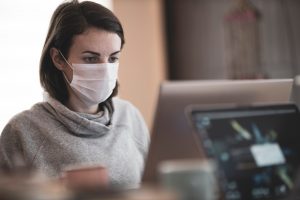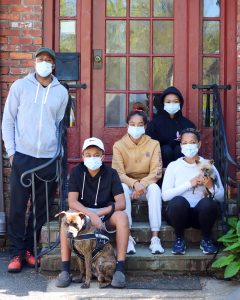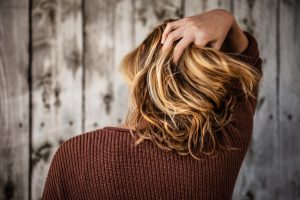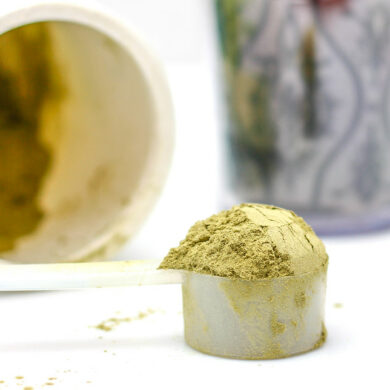Like a prism of glass held up to light, our perception of the world around us is largely defined by the lens through which we look. The lens of COVID-19 is unprecedented in its ability to impact cultures across the entire world as a collective and international trauma. Even the English language has been greatly affected by the pandemic, as dictionaries now implement a faster announcement system to introduce new COVID-19 related words such as “PPE” and “face covering” to the public.
COVID-19 has had an impact at the individual level as well. People who have contracted COVID-19 and continue to experience persisting symptoms might have long-term effects on their quality of life.

As of March 2021, over 30.4 million Americans had tested positive for COVID-19, meaning that the presence of genetic material of the coronavirus, RNA, was detected in their body. Those who test positive for COVID-19 either could be asymptomatic or experience symptoms. While an asymptomatic person is still considered contagious and could spread the virus to others, they do not suffer the common COVID-19 symptoms.
Through a doctor’s diagnosis, symptomatic cases are categorized by the patient’s symptom intensity on a scale of 1-4 and its duration. Those who experience a mild (1) case are the majority of total COVID-19 cases (81%). They will self isolate at home and recover from their symptoms within one to two weeks. Even a mild case includes symptoms such as body aches, headaches, pounding heartbeat, loss of smell and taste, or fever to name just a few. Moderate (2) and severe (3) cases both require hospitalization, the latter involving ventilator support at an intensive care unit (ICU). Finally, patients with critical (4) cases experience multiorgan failure, which can include anything from acute lung and liver failure to acute kidney injury and cardiovascular disease.

While the percentage of severe cases is quite low at only five percent, this does not lessen the severity of the long-term effects that COVID-19 can have on any person, whether they have a mild, moderate or severe case. Regardless of symptom severity, if a person has a symptom that lasts longer than two weeks, known as symptom persistence, that person has what is referred to as post-acute COVID-19 syndrome, commonly known as “Long COVID” or “COVID long hauling.”

This type of COVID does not merely affect a small fraction of people, either. In a study of hospitalized COVID-19 patients in Italy, 87.4% of patients reported a persistence of symptoms like fatigue, dyspnea, joint pain, and chest pain 60 days after their first symptom appeared. Some might argue this percentage is high solely because patients in the study had severe enough symptoms to require hospitalization; however, another study done by the University of Washington in February 2021 found that 31% of participants that formerly contracted COVID-19 reported at least one persistent symptom. The cohort included people who had never been hospitalized for COVID-19 (91%) and a diverse range of ages, 27% of which were ages 18-36. The reappearance of this trend in such a diverse sample demonstrates that even young people and non-hospitalized COVID patients are not exempt from persisting symptoms.
In fact, many COVID long-haulers have found that mild cases do not correlate to a better quality of life after initial contraction of the disease. Kirra, a third year transfer at UC San Diego, watched her 40-year-old mother and her 17-year-old sister experience “Long Covid” in unique ways; her relatives endured symptoms such as altered taste and hair loss, each of which were independently debilitating. Both Kirra’s mother and sister contracted the virus back in July 2020 and have still not fully recovered after nine months, as they still experience altered smell and taste. Since Kirra was the only member of her family not to contract the coronavirus, she took care of her family and shared her experiences as a young adult caretaker in the previous blog of this series.
Kirra’s sister experienced anosmia, an alteration in a person’s smell that can then affect one’s sense of taste–a symptom that she still experiences today. Neurons convert the chemical signal of one of her favorite foods, like garlic, into an electrical signal. This signal can then be recognized and processed by the brain through a mechanism called chemosensation, which tells Kirra’s sister that she is eating food that contains garlic. Since smell handles 95-99% of chemosensation, while taste only accounts for the small leftover percentage, is it easy to see how disturbing one’s smell can throw off their perception of food.
At the start of her diagnosis, Kirra’s sister could not tolerate the taste of garlic and cooked onions. Only now, 9 months later, she can tolerate them if they are not present in the same dish together. However, the extent of her anosmia has made her resort to a vegetarian diet, since the taste of meat has become unbearable to her. Whereas Kirra’s sister used to be an adventurous eater before contracting COVID-19, she now has to slowly reintroduce all strongly flavored foods back into her diet in small amounts.

Another COVID-19 symptom that is not often highlighted by the media is telogen effluvium, or reversible hair loss condition. After her initial month in quarantine, Kirra’s mother would pull out clumps of hair when she brushed it. Worried, she searched online and found forums full of women who had the same experience. COVID-19 long haulers experience hair loss due to prolonged stress and, in some circumstances, high fevers following this stress.
In order to understand how COVID-19 affects hair loss, we must first understand that our hair has a life cycle broken up into three distinct phases. For three to six years, our hair is in the growing, or Anagen, phase before it reaches a brief phase called Catagen. During the Catagen or involution phase, hair follicles shrink and are partially destroyed, thus cutting off blood flow to the hair. Lack of blood flow also means lack of nutrient supply to hair follicles, and this transitions the hair into the Telogen phase, in which the hair either rests with no growth or sheds.
Certain factors, such as prolonged stress caused by isolation from family and loved ones, physical repercussions of COVID-19 symptoms, and one’s own mortality, can trigger the hair’s Telogen phase. Kirra’s mother, after having been a COVID-19 survivor alongside with three other members of her family, certainly had undergone a stressful time, and like others with telogen effluvium, up to 50% of her hair went into the shedding phase.

People with Long COVID will experience telogen effluvium for six to nine months, and will slowly grow that lost hair back. At the time of this article, Kirra’s mother has seen significant improvement in her hair growth. Because of this long timeline, it is difficult to track how many people experience hair loss due to COVID-19 or the pandemic itself. However, a study in China that followed the recovery of 1700 people through medical questionnaires and physical examinations found that 22% of hospitalized COVID-19 patients reported hair loss six months later.
Additionally, hair loss can be triggered by acute high fevers following physiological stress, like contracting a virus and quarantining while isolated from loved ones. When a person is sick and has a fever, cells of the immune system secrete molecules called cytokines, which largely affect cell to cell communication. These cytokines initiate apoptosis, or induced cell death, of hair follicle cells that produce the protein keratin that makes up your hair. Because these dead cells are unable to produce keratin, your hair then enters the shedding phase.
Although sense of smell and hair loss are not lethal symptoms, they can certainly affect one’s quality of life. Many people have not taken COVID-19 seriously because of the low mortality rate, as death occurs in only one to two percent of all COVID cases in the United States. Although this percentage appears small, this mindset encourages us to overlook the quality of life for those with persisting COVID-19.

Kirra’s family and their experience with COVID-19 is a brief snapshot of how the coronavirus can affect one’s everyday life. Now, at the start of every meal, Kirra’s sister must consider the changes in her diet and abstain from some of her favorite foods. Losing hair is not an easy journey, either. American culture places a lot of beauty standards and professionalism on hair, as we have seen countless businesses criticize or ask women to change their length or style of their natural hair. Women with rapid hair loss might feel pressured to live up to these societal expectations, to consider expensive extensions or wigs. Learning to navigate a society that glorifies one specific physical appearance and ostracizes others is an additional weight placed on COVID-19 survivors like Kirra’s mother.
The COVID-19 has no doubt changed our world. However, when we discuss the pandemic, we should not only emphasize its fatal impact but also consider its ability to alter our quality of life.
Living isn’t about just surviving.
List of links:
- https://public.oed.com/blog/using-corpora-to-track-the-language-of-covid-19-update-2/
- https://www.nytimes.com/interactive/2020/us/coronavirus-us-cases.html
- https://www.webmd.com/diabetes/qa/what-is-the-definition-of-asymptomatic
- https://www.mayoclinic.org/diseases-conditions/coronavirus/in-depth/coronavirus-long-term-effects/art-20490351
- https://medcraveonline.com/JLPRR/JLPRR-07-00230.pdf
- https://www.ncbi.nlm.nih.gov/pmc/articles/PMC7533045/
- https://www.nature.com/articles/s41591-021-01283-z?utm_source=Nature+Briefing&utm_campaign=d5a18a3501-briefing-dy-20210329&utm_medium=email&utm_term=0_c9dfd39373-d5a18a3501-44594221#Sec9
- https://jamanetwork.com/journals/jama/fullarticle/2768351
- https://jamanetwork.com/journals/jamanetworkopen/fullarticle/2776560
- https://sqonline.ucsd.edu/2021/03/a-student-caretakers-perspective-on-covid-19/
- https://sqonline.ucsd.edu/2021/03/a-student-caretakers-perspective-on-covid-19/
- https://www.webmd.com/lung/news/20200723/hair-loss-an-unexpected-covid-misery-for-many
- https://www.ncbi.nlm.nih.gov/pmc/articles/PMC4606321/
- https://www.ncbi.nlm.nih.gov/pmc/articles/PMC2785020/
- https://www.nytimes.com/interactive/2020/us/coronavirus-us-cases.html
- https://www.psych.ox.ac.uk/news/largest-study-to-date-suggests-link-between-covid-19-infection-and-subsequent-mental-health-and-neurological-conditions
Image Sources:

